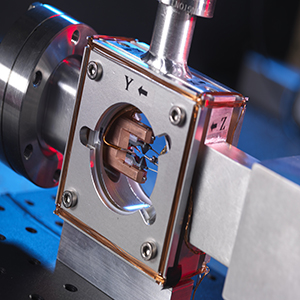2 minute read
Scientists at NPL and the University of Sussex have teamed up to search for a breakdown in the laws of physics, using frequency data from NPL’s atomic clocks.
In a paper recently published in New Journal of Physics the scientists explain how they used the high precision of atomic clocks to attempt to detect any variations in the rate at which atomic clocks “tick”, which would provide evidence of novel physical phenomena such as dark matter.
.jpg?lang=en-GB) The frequency of an atomic clock (the rate at which it “ticks”) should be constant according to the currently established laws of physics. However, if dark matter existed it could interact very weakly with atomic clocks and cause tiny changes in their frequencies over time. It is these tiny changes in frequency that the collaboration tried to detect. The results produced by this work place competitive constraints on possible couplings between ultralight scalar dark matter and ordinary matter, as well as showing that data from atomic clocks could be used in future to study axion-like couplings with greater sensitivity than neutron electric dipole moment experiments.
The frequency of an atomic clock (the rate at which it “ticks”) should be constant according to the currently established laws of physics. However, if dark matter existed it could interact very weakly with atomic clocks and cause tiny changes in their frequencies over time. It is these tiny changes in frequency that the collaboration tried to detect. The results produced by this work place competitive constraints on possible couplings between ultralight scalar dark matter and ordinary matter, as well as showing that data from atomic clocks could be used in future to study axion-like couplings with greater sensitivity than neutron electric dipole moment experiments.
As NPL continues to improve the performance of its atomic clock technology, scientists will be able to search for a wider range of phenomena by detecting even smaller changes in atomic clock frequencies.
Dr. Rachel Godun, principal scientist at NPL, said: “It is exciting to be able to use atomic clocks for applications that go far beyond timekeeping and could help answer some of the big questions in modern physics.”
Adam Parsons, higher scientist at NPL, said: “This project was a great example of cross-disciplinary collaboration between experimentalists and theoreticians, involving the application of cutting-edge ideas in particle theory to data produced by state-of-the-art experiments. We look forward to participating in many similar ventures in the future”
Find out more about NPL’s work in Time and frequency
05 Oct 2023